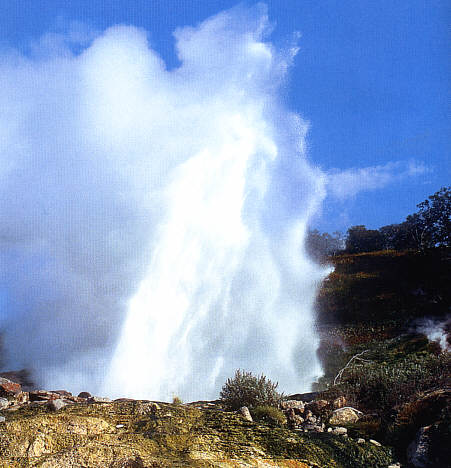Geyser Valley - Kamchatka

Geyser Valley - Kamchatka |  |
|---|

The Geyser Valley is a unique and world-famous natural feature situated on the east of Kamchatka Peninsula, about 200 kilometres north east of Petropavlovsk. It was discovered in 1914 by the Russian geologist T.Ustinova. She found many geysers, hot springs, boiling mud, vapour springs and hot lands close to the river Shumnaya. Scientists of different fields started exploring and studying this area in 1940ies to explain why these geysers and hot springs appear, how they operate and to discover their influence on the surrounding areas.
Geysers are natural hot springs with a permanent rhythmical activity and are quite rare. The cycle of geyser activity consists of several phases. During the initial phase, water fills an underground basin and then a pool located at ground level. On it's way up to the surface the superheated water depressurises and starts boiling. The water converts into vapour and increases its volume very rapidly, so the geyser starts exploding. These eruptions are very loud. The fountains of hot water may be vertical, e.g. geysers "Velikan" (The Giant) and "Bolshoi" (The Great), or inclined, e.g. geysers "Triple" and "Pioneer". The fountain of Velikan Geyser is 2 meters in diameter and reaches up to 30 meters. Other geysers are not so huge, although they are also very impressive. After eruption comes the phase of evaporation, and when the vapour disappears it leaves the drying empty mouth of a geyser. At the same time under the ground the water starts filling for the next eruption. The duration of a full cycle varies from geyser to geyser, eg "Velikan" erupts every 3 hours, the "Triple" Geyser erupts once in 2½ hours and "Smaller" Geyser erupts every 30 minutes.
Pulsating Hot Springs differ from geysers as they are continuously erupting with very short calm periods. For example "Sakharnyi" (Sugar) Hot Spring has eruptions every 4-5 minutes, with a duration of about 2 minutes. The small pools of these hot springs are always full of boiling water pouring over the edges and forming small streams. Some of the pulsating hot springs had been geysers in the past, but changed their character for natural reasons (mainly micro relief changes) or because of human activity.
Every second there are about 250-300 litres of thermal water pouring out in the Geyser Valley. The various hydrothermal phenomena of Geyser Valley influence their local environment, such as rock, relief, air, soil, flora and fauna. The air has a permanent chemical laboratory smell as water vapours produced by geysers and fumaroles are associated with hydrogen sulfide, methane and other gases. Thermal grounds do not get a permanent snow cover during the winter. The vegetation bursts into bud earlier in spring, birds start making nests, insects and brown bears wake up earlier.
The varied mineral compositions and temperatures of natural springs has resulted in some having health and medical resorts built around them.
See also Kronotski Reserve.
Home Asia Africa Europe Maps
ALW 2/9/2014